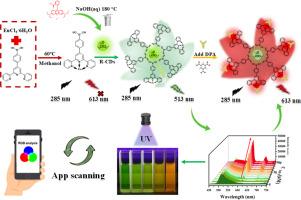三联吡啶Eu(III)配合物结合硼酸功能化碳点用于炭疽孢子生物标志物的现场视觉比例荧光检测
IF 4.6
2区 化学
Q1 SPECTROSCOPY
Spectrochimica Acta Part A: Molecular and Biomolecular Spectroscopy
Pub Date : 2025-09-17
DOI:10.1016/j.saa.2025.126958
引用次数: 0
摘要
开发鉴定潜在生物标志物的可靠方法对于早期发现严重疾病和病症具有至关重要的意义。在这项工作中,我们设计了一种新的三元吡啶Eu(III)配合物与硼酸功能碳点荧光探针Eu- tpy /R-CDs,用于比例检测二吡啶酸(DPA)。采用溶剂法将绿色发光罗丹宁B碳点共组装并固定在三吡啶-铕(III)配合物的硼酸基体上,制备了Eu-Tpy/R-CDs纳米探针。该新型纳米探针Eu-Tpy/R-CDs可作为多色比荧光检测平台,用于水介质和实际孢子中的痕量DPA。该传感系统对DPA具有良好的线性关系,线性范围为6.67 ~ 73.33 μM,检测限为80.34 nM,显著低于炭疽的感染剂量(~ 55 μM)。更重要的是,将基于Eu-Tpy/ r - cd的检测试卷与智能手机相结合,可以实现对DPA的敏感、实时和视觉检测。本文章由计算机程序翻译,如有差异,请以英文原文为准。

Terpyridine Eu(III) complexes combined with boric acid-functionalized carbon dots for on-site visual ratiometric fluorescence detection of anthrax spore biomarkers
The development of reliable methodologies for the identification of potential biomarkers holds paramount significance for the early detection of serious diseases and conditions. In this work, we have designed a new terpyridine Eu(III) complexes with boric acid functional carbon dot-based fluorescent probe Eu-Tpy/R-CDs for the ratiometric of detection of dipicolinic acid (DPA). Eu-Tpy/R-CDs nanoprobe were obtained by co-assembly and immobilization of green luminescent Rhodanine B carbon dots to boric acid matrix sites in tripyridine‑europium (III) complexes using the solvent method. The novel nanoprobe Eu-Tpy/R-CDs can be used as a multicolor ratio fluorescence sensing platform for trace DPA in both aqueous media and actual spores. The sensing system exhibited a linear relationship for DPA, with a broad linear range of 6.67–73.33 μM and a limit of detection of 80.34 nM, which is significantly below the infectious dosage of anthrax (∼55 μM). More prominently, combining Eu-Tpy/R-CDs based detection test papers with a smartphone can achieve sensitive, real-time, and visual detection of DPA.
求助全文
通过发布文献求助,成功后即可免费获取论文全文。
去求助
来源期刊
CiteScore
8.40
自引率
11.40%
发文量
1364
审稿时长
40 days
期刊介绍:
Spectrochimica Acta, Part A: Molecular and Biomolecular Spectroscopy (SAA) is an interdisciplinary journal which spans from basic to applied aspects of optical spectroscopy in chemistry, medicine, biology, and materials science.
The journal publishes original scientific papers that feature high-quality spectroscopic data and analysis. From the broad range of optical spectroscopies, the emphasis is on electronic, vibrational or rotational spectra of molecules, rather than on spectroscopy based on magnetic moments.
Criteria for publication in SAA are novelty, uniqueness, and outstanding quality. Routine applications of spectroscopic techniques and computational methods are not appropriate.
Topics of particular interest of Spectrochimica Acta Part A include, but are not limited to:
Spectroscopy and dynamics of bioanalytical, biomedical, environmental, and atmospheric sciences,
Novel experimental techniques or instrumentation for molecular spectroscopy,
Novel theoretical and computational methods,
Novel applications in photochemistry and photobiology,
Novel interpretational approaches as well as advances in data analysis based on electronic or vibrational spectroscopy.

 求助内容:
求助内容: 应助结果提醒方式:
应助结果提醒方式:


